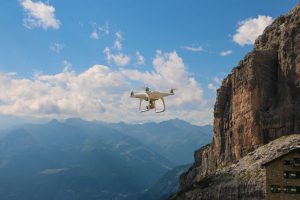
DJI, the world’s leading drone manufacturer, has released “the first-ever survey of lifesaving drone activity.” “Lives Saved: a Survey of Drones in Action” finds that drones, often operated by bystanders or volunteers, have been directly responsible for saving at least 59 lives; and are doing so more and more frequently – at the current rate of almost one per week.
“The clear conclusion is that drones are regularly saving lives around the world. This is occurring even though professional rescue crews are just beginning to adopt UAS technology, and in many cases are relying on bystanders or volunteers to provide lifesaving assistance,” concludes the report from DJI’s Policy & Legal Affairs Department. “DJI is at the forefront in efforts to develop best practices and optimal standards for firefighters, rescue services and other first responders to integrate drones into their command protocols. As these efforts continue, we expect the number of lives saved by drones to continue to grow.”
 Based on media reports collected from around the world, the count includes rescues on land, during floods and disasters, search and rescue operations, and on water. The 59 incidents don’t include those where drones were an instrumental part of a multi-function rescue team – such as the hundreds of lives saved in a coordinated effort to identify people stranded by flooding in India by drone in order to direct land-based rescue teams – but only those occasions when a drone was the sole instrument used.
Based on media reports collected from around the world, the count includes rescues on land, during floods and disasters, search and rescue operations, and on water. The 59 incidents don’t include those where drones were an instrumental part of a multi-function rescue team – such as the hundreds of lives saved in a coordinated effort to identify people stranded by flooding in India by drone in order to direct land-based rescue teams – but only those occasions when a drone was the sole instrument used.
The paper is designed to showcase the importance and benefit that the widespread use of both commercial and recreational drones have for humanity, and to offer some balance to repeated media headlines about “near misses” and the dangers of drones. The summary of rescue incidents provides some interesting insights:
- At least 59 lives have been saved by civilian drones in 18 different incidents
- 38 of those lives were saved in just the last 10 months, as drones are increasingly adopted by rescuers and civilians alike
- Based on this experience, drones are saving almost one life a week on average
- 20 of those lives (34%) were saved by civilians using their drones to assist in a rescue scenario
- 31 lives were saved during floods, as drones spotted missing people and in some cases delivered rescue ropes and life jackets so they could be brought to safety
- Another 19 missing people were found on land, on terrain ranging from swamps to mountains to snowbanks
- Nine more people were rescued from non-flooded water environments, including off beaches or in boats
Outlining each documented case, the paper provides a fascinating view of drone capabilities – and the generous community of drone operators. “Drones have proven their worth in rescues all over the world, and this report is the first formal attempt to show how both professional emergency services and helpful hobbyists have used them to save lives,” Adam Lisberg, DJI’s North American Corporate Communications Director tells DRONELIFE. “DJI is working with rescue services on how to best integrate drones into existing incident management protocols, and we expect to see even more stories of amazing drone rescues in the future.”

Miriam McNabb is the Editor-in-Chief of DRONELIFE and CEO of JobForDrones, a professional drone services marketplace, and a fascinated observer of the emerging drone industry and the regulatory environment for drones. Miriam has penned over 3,000 articles focused on the commercial drone space and is an international speaker and recognized figure in the industry. Miriam has a degree from the University of Chicago and over 20 years of experience in high tech sales and marketing for new technologies.
For drone industry consulting or writing, Email Miriam.
TWITTER:@spaldingbarker
Subscribe to DroneLife here.







[…] thermal imaging camera. That brings the total to more than 500 lives saved by drones, according to DJI’s project counting the lives that would have been lost without direct intervention of drone […]